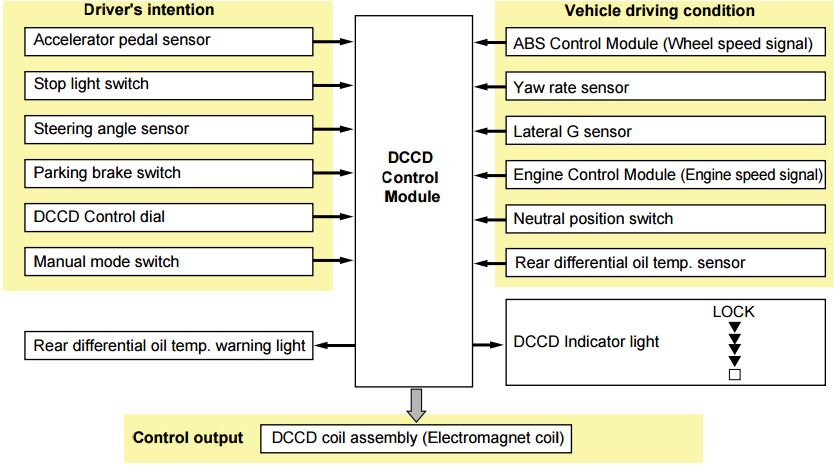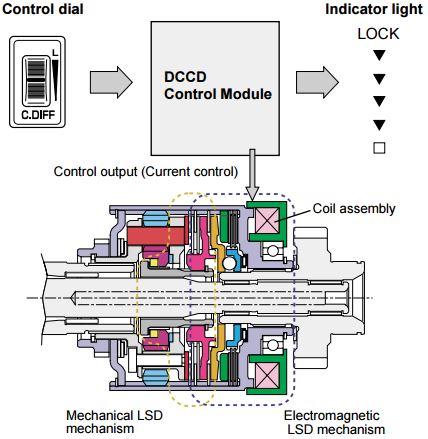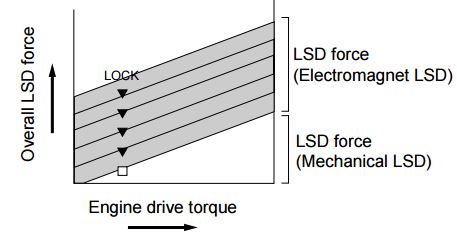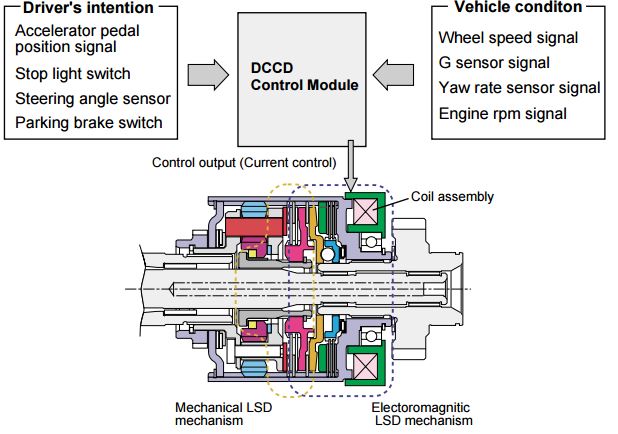DCCD Subaru STi Explained:
System operation
The DCCD system input/output items are shown in the figure below. The system consists of sensors detecting “driver’s intention” such as a steering angle sensor, those detecting “vehicle conditions” such as yaw rate and lateral G sensors and DCCD coil that controls engagement force of the electromagnetic clutch LSD.

System control is available in one of two modes: manual and auto. Operations in each mode are as follows:
Manual mode: The system controls the magnetic clutch LSD to acquire the differential limiting force set on the control dial.
Auto mode: Based on information from sensors detecting “driver’s intention” and those detecting “vehicle conditions”, the system executes electromagnetic clutch LSD control considering the driver’s intention.
DCCD Subaru STi Explained:
Manual Mode Operation
Pressing the Manual Mode switch causes the DCCD system to be placed in manual mode. In this mode, the control dial can be used to arbitrarily adjust the magnetic clutch LSD limiting force ranging from free to lock.

The DCCD control module gives certain current determined by setting on the control dial to the coil. It causes the magnetic clutch LSD differential limiting force to be fixed to a certain value.
The chart given below shows differential limiting force characteristics of the whole center differential containing the mechanical LSD. When the control dial is set to its lowest position, the coil current is zero and the magnetic clutch LSD is free, with only the mechanical LSD functioning. When the control dial is set to the LOCK position, the coil current is the maximum, with the highest differential limiting force generated by the magnetic clutch LSD.

is set to its lowest position, the coil current is zero and the magnetic clutch LSD
is free, with only the mechanical LSD functioning.
Notes:
When the ignition switch is set OFF in manual mode, the DCCD system automatically returns to auto mode. Because the differential limiting force by the mechanical LSD is active even if it is set free in manual mode, the LSD function of the center differential is not completely freed.
DCCD Subaru STi Explained:
Auto Mode Operation
In auto mode, the differential limiting force of the electromagnetic clutch LSD is automatically adjusted according to the driver’s intention and vehicle driving conditions. Of various controls including engine driving force sensitive control and ABS differential signal input control, this section discusses system operations including the vehicle running characteristics, using an example of cornering control.

Controls in auto mode
– Engine driving force sensitive control
Optimum control of the electromagnetic clutch LSD engagement force, estimating the driving force from the throttle travel, engine rotational speed and prospective gear ratio, aiming to compensate the mechanical LSD characteristics.
– Brake switch signal input control
Control of electromagnetic clutch LSD engagement force so that the brake performance can be maximized.
– Parking brake switch signal input control
Releasing the electromagnetic clutch LSD when the parking brake is applied.
– Tight cornering control
Reducing the electromagnetic clutch LSD engagement force during turning at low speed to prevent occurrence of tight corner braking phenomena.
– Slip control
Controlling the electromagnetic clutch LSD engagement force depending on the slippage, if any, detected through four wheel speed signals.
– Cornering control
Control that satisfies both controllability and stability of a turning vehicle. Maintaining the best cornering performance by controlling the pilot clutch engagement force based on the driver’s intention and vehicle turning conditions determined from a steering angle, yaw rate and lateral G sensors and vehicle speed.
